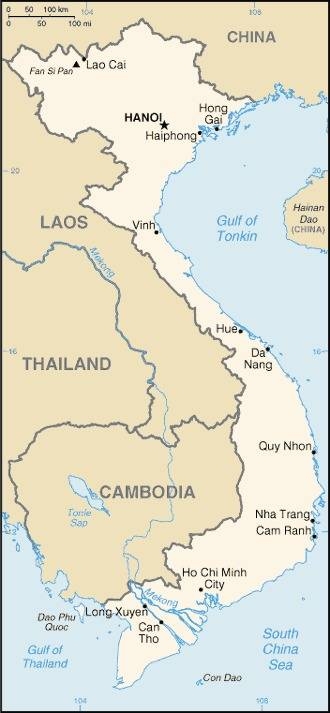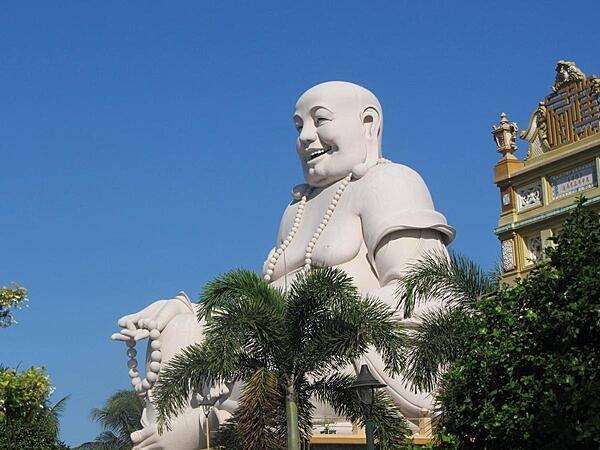175 Vietnam

Red field with a large yellow five-pointed star in the center. Red symbolizes revolution and blood, the five-pointed star represents the five elements of the populace – peasants, workers, intellectuals, traders, and soldiers – that unite to build socialism.
Flag courtesy of the CIA World Factbook

Map courtesy of the CIA World Factbook

Laughing Buddha at the Vinh Trang Pagoda near the city of My Tho. First completed in 1851, the Vinh Trang temple has been reconstructed a number of times.
Photo courtesy of the CIA World Factbook
Government
According to Britannica, the first constitution of the Socialist Republic of Vietnam, adopted in 1980, established a Council of State as a collective presidency and a Council of Ministers. In 1992 this document was superseded by a second constitution, which, in addition to replacing the Council of State with an elected president and otherwise reforming Vietnam’s government and political structure, also outlined major shifts in foreign policy and economic doctrine. In particular, it stressed the development of all economic sectors, permitted private enterprise, and granted foreign investors the right to legal ownership of their capital and assets while guaranteeing that their property would not be nationalized by the state.
A unicameral, popularly elected National Assembly is the supreme organ of the government. It elects the president, who is head of state, and the vice president, who is nominated by the president. The cabinet consists of the prime minister, who is nominated by the president and approved by the National Assembly, and deputy prime ministers and the heads of government ministries and various state organizations, who are named by the prime minister and confirmed by the Assembly. The cabinet (which superseded the earlier Council of Ministers) coordinates and directs the ministries and various state organizations of the central government and supervises the administrative committees at the local government level.
Initially, administrative responsibilities were divided along narrow functional lines among many ministries; there were, for example, numerous economic ministries concerned with agriculture and the food industry, marine products, forestry, and water conservancy. In the mid-1980s, such smaller ministries were consolidated to streamline the system. Larger ministries now tend to be relatively self-sufficient, with their own colleges, training institutions, and health, social, and cultural facilities. There are also several commissions under the cabinet, such as the State Inspectorate. The prime minister’s office oversees a number of general departments beneath the ministerial level and committees that are formed to supervise major projects which involve more than one ministry.
Initially, administrative responsibilities were divided along narrow functional lines among many ministries; there were, for example, numerous economic ministries concerned with agriculture and the food industry, marine products, forestry, and water conservancy. In the mid-1980s, such smaller ministries were consolidated to streamline the system. Larger ministries now tend to be relatively self-sufficient, with their own colleges, training institutions, and health, social, and cultural facilities. There are also several commissions under the cabinet, such as the State Inspectorate. The prime minister’s office oversees a number of general departments beneath the ministerial level and committees that are formed to supervise major projects which involve more than one ministry.
The judicial system consists of courts and tribunals at various levels and the Supreme People’s Procuracy. The National Assembly supervises the work of the Supreme People’s Court, which is the highest court of appeal and the court of first instance for special cases (such as treason). This court, in turn, supervises the judicial work of both the local People’s Courts, which are responsible to their corresponding People’s Councils, and the Military Tribunals. The People’s Courts function at all levels of government except the commune, where the commune administrative committee functions as a primary court.
The Supreme People’s Procuracy, with its local and military subdivisions, acts as a watchdog for the state. It monitors the performance of government agencies, maintains vast powers of surveillance, and acts as a prosecutor before the People’s Courts. The Supreme People’s Procuracy is responsible to the National Assembly, or to its Standing Committee, when the Assembly is not in session.
Civil Aviation Administration (CAA)
The Civil Aviation Administration (CAA) of Vietnam is an agency directly under the Ministry of Transport, performing the function of advising and assisting the Minister of Transport in the state management of civil aviation nationwide; directly performing the duties and powers of the aviation authorities in accordance with the law and international treaties to which the Socialist Republic of Vietnam is a signatory. The CAA of Vietnam has legal status, a seal with the national emblem, has its own account in accordance with the law, and is headquartered in Hanoi. The international transaction name is “Civil Aviation Authority of Vietnam”.
Airspace
SkyVector – Google Maps – ADS-B Exchange
ICAO countries publish an Aeronautical Information Publication (AIP). This document is divided into three parts: General (GEN), En Route (ENR) and Aerodromes (AD). ENR 1.4 details the types of airspace classes they chose to adopt from classes A through G.
Vietnam AIP – requires login
Drone Regulations
Drone Regulations translated by Luca A. Pierangelo





Advanced Air Mobility (AAM) Regulations & Policies
None found by the author.
However, should you, the reader, happen to stumble across something to the contrary, please email the author at FISHE5CA@erau.edu and you may be mentioned in the ACKNOWLEDGEMENTS section of this book by way of thanks for contributing to this free eBook!
Advanced Air Mobility (AAM) News
2025
Video courtesy of Advanced Air Mobility Institute from the January 2025 Global AAM Forum. Complete session for Day 3 of this Forum is available on the Advanced Air Mobility Institute YouTube Channel
2023 – SkyDrive and CT UAV Sign MoU to order 100 eVTOLs and Advance Aerial Mobility in Vietnam
Short Essay Questions
Scenario-Based Question
You have been hired by a Drone Startup Company. Your boss has immediately assigned this job to you.
They need you to prepare a one-page memo detailing the legalities of using a drone to film the Laughing Buddha near My Tho, pictured above.
They need you to mention any national laws and local ordinances.
They specifically want to know what airspace (insert pictures) you will be operating in and whether or not you need an airspace authorization.
Does it matter whether or not you are a citizen of the country?
Lastly, there is a bonus for you if, as you scroll through this chapter, you find any typos or broken links!
Short Essay Questions
- What are the drone categories?
- How is registration addressed?
- How is remote ID addressed?
- What are the model aircraft rules?
- What are the commercial drone rules?
- Are there waivers or exemptions to the rules? If so, for what?
- Would you share a link to an interactive airspace map?
- How is BVLOS addressed?
- How can you fly drones at night?
- How can you fly drones over people?
- Where do you find drone NOTAMs?
- What are the rules for drone maintenance?
- What are the rules for an SMS program?
- What are some unique rules not mentioned above?
- What are the C-UAS rules?
- What are the AAM rules?

